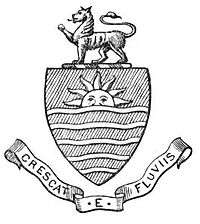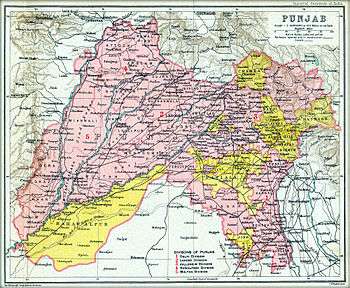Punjab States Agency
| Punjab States Agency पंजाब, پنجاب | |||||
| British Residency | |||||
| |||||
 | |||||
 | |||||
| Historical era | New Imperialism | ||||
| • | Established | 1933 | |||
| • | British withdrawal from India | 1947 | |||
| Area | |||||
| • | 1921 | 86,430 km2 (33,371 sq mi) | |||
| Population | |||||
| • | 1921 | 465,493 | |||
| Density | 5.4 /km2 (13.9 /sq mi) | ||||
| Today part of | Punjab, India | ||||
The Punjab States Agency was a political office of the British Indian Empire. The agency was created in the 1930s, on the model of the Central India Agency and Rajputana Agency, and dealt with forty princely states in northwest India formerly dealt with by the British province of the Punjab.[1][2][3]
After 1947, most of the states chose to accede to the Union of India, the rest to the Dominion of Pakistan.
History
| Princely state |
|---|
| Individual residencies |
| Agencies |
|
| Lists |
The princely states had come under the suzerainty of the British crown after the Anglo-Nepalese War of 1814–16 and went on to be known as the Punjab Native States and the Simla Hill States. They later came into direct diplomatic relations with the British province of Punjab, with the exception of Tehri Garhwal State, which had a connection instead with the United Provinces.[4]
The Punjab States Agency was established in 1933 out of the previous Punjab Native States, which had received advice from the Lieutenant Governor of Punjab Province, and the Simla Hill States, advised by the Deputy Commissioner of Simla district.[5] The agency was created under the direct authority of the Governor General of India, with its headquarters in Shimla.[6]
After Indian Independence in 1947, the states all acceded to the new Dominion of India, most of them later becoming part of the new state of Himachal Pradesh, with Tehri Garhwal State becoming part of Uttar Pradesh. In 2000, the northern portion of Uttar Pradesh, including the former state of Tehri-Garhwal, became the new state of Uttarakhand.
Princely states
Punjab States Agency
Salute states, by precedence :
- Patiala, title Maharaja, Hereditary salute of 17-guns (19-guns local)
- Bahawalpur (now in Pakistan), title Nawab, Hereditary salute of 17-guns (later promoted to 21 guns by the Pakistani president)
- Jind, title Maharaja, Hereditary salute of 13-guns (15-guns personal and local)
- Kapurthala, title Maharaja, Hereditary salute of 13-guns (15-guns personal and local)
- Nabha, title Maharaja, Hereditary salute of 13-guns (15-guns local)
- Kaithal, title Bhai ( Maharaja) Hereditary salute 13-guns (15-guns local)
- Bilaspur (Kahlur), title Raja, Hereditary salute of 11-guns
- Chamba, title Raja, Hereditary salute of 11-guns
- Faridkot, title Raja, Hereditary salute of 11-guns
- Maler Kotla (Malerkotla), title Nawab, Hereditary salute of 11-guns
- Mandi, title Raja, Hereditary salute of 11-guns
- Sirmur (Nahan), title Maharaja, Hereditary salute of 11-guns
- Suket (Sundarnagar), title Raja, Hereditary salute of 11-guns
- Loharu, title Nawab, Hereditary salute of 9-guns
Non-salute states, alphabetically :
Historical princely states of the Punjab Hills
Simla Hill States Superintendency of the Punjab States Agency
- Bashahr, title Raja, Personal 9 guns-salute
Non-salute states, alphabetically :
See also
References
- ↑ David P. Henige (2004). Princely states of India: a guide to chronology and rulers. Orchid Press. ISBN 978-974-524-049-0.
- ↑ Princely States of India
- ↑

- ↑ V. Verma, The Emergence of Himachal Pradesh: A Survey of Constitutional Developments, pp. 41-42
- ↑ John Hutchison and JP Vogel, History of Punjab Hill states; Lahore 1933
- ↑ Ramesh Chandra Bisht, International Encyclopaedia Of Himalayas, Vol. 3, p. 104